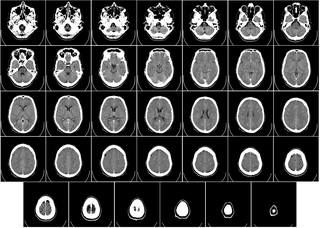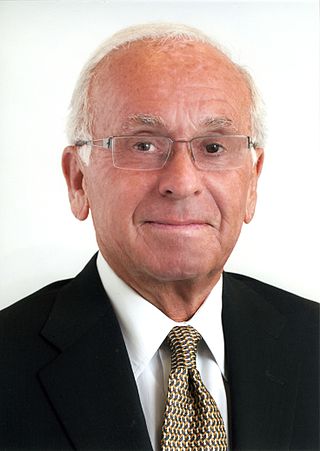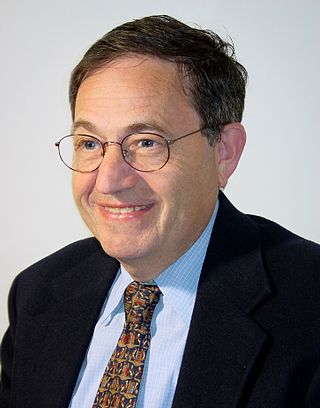Related Research Articles

Magnetic resonance imaging (MRI) is a medical imaging technique used in radiology to form pictures of the anatomy and the physiological processes of the body. MRI scanners use strong magnetic fields, magnetic field gradients, and radio waves to generate images of the organs in the body. MRI does not involve X-rays or the use of ionizing radiation, which distinguishes it from CT and PET scans. MRI is a medical application of nuclear magnetic resonance (NMR) which can also be used for imaging in other NMR applications, such as NMR spectroscopy.

Radiology is the medical discipline that uses medical imaging to diagnose diseases and guide their treatment, within the bodies of humans and other animals. It began with radiography, but today it includes all imaging modalities, including those that use no electromagnetic radiation, as well as others that do, such as computed tomography (CT), fluoroscopy, and nuclear medicine including positron emission tomography (PET). Interventional radiology is the performance of usually minimally invasive medical procedures with the guidance of imaging technologies such as those mentioned above.

Neuroimaging is the use of quantitative (computational) techniques to study the structure and function of the central nervous system, developed as an objective way of scientifically studying the healthy human brain in a non-invasive manner. Increasingly it is also being used for quantitative studies of brain disease and psychiatric illness. Neuroimaging is a highly multidisciplinary research field and is not a medical specialty.
William Henry Oldendorf was an American neurologist, physician, researcher, medical pioneer, founding member of the American Society for Neuroimaging (ASN), and originator of the technique of computed tomography.
MRI contrast agents are contrast agents used to improve the visibility of internal body structures in magnetic resonance imaging (MRI). The most commonly used compounds for contrast enhancement are gadolinium-based. Such MRI contrast agents shorten the relaxation times of nuclei within body tissues following oral or intravenous administration.

Magnetic resonance imaging of the brain uses magnetic resonance imaging (MRI) to produce high quality two-dimensional or three-dimensional images of the brain and brainstem as well as the cerebellum without the use of ionizing radiation (X-rays) or radioactive tracers.

Computed tomography of the head uses a series of X-rays in a CT scan of the head taken from many different directions; the resulting data is transformed into a series of cross sections of the brain using a computer program. CT images of the head are used to investigate and diagnose brain injuries and other neurological conditions, as well as other conditions involving the skull or sinuses; it used to guide some brain surgery procedures as well. CT scans expose the person getting them to ionizing radiation which has a risk of eventually causing cancer; some people have allergic reactions to contrast agents that are used in some CT procedures.

Val Murray Runge is an American and Swiss professor of radiology and the editor-in-chief of Investigative Radiology. Runge was one of the early researchers to investigate the use of gadolinium-based contrast agents for magnetic resonance imaging (MRI), giving the first presentation in this field, followed two years later by the first presentation of efficacy. His research also pioneered many early innovations in MRI, including the use of tilted planes and respiratory gating. His publication on multiple sclerosis in 1984 represented the third and largest clinical series investigating the role of MRI in this disease, and the first to show characteristic abnormalities on MRI in patients whose CT was negative.
Camilo Ramiro Gomez, is an American neurologist, medical educator, and researcher. He is one of the first 100 vascular neurologists certified by the American Board of Psychiatry and Neurology (ABPN), and one of the founders of the subspecialty of interventional neurology in the United States.

Ronald J. Ross is a Cleveland, Ohio radiologist known for research on brain injury in professional and amateur boxers and for the first clinical use of nuclear magnetic resonance imaging on human patients. Ross is also credited with the first use of head and whole body computed tomography imaging (CT) in a private clinical setting in the United States.
Bruce Rosen is an American physicist and radiologist and a leading expert in the area of functional neuroimaging. His research for the past 30 years has focused on the development and application of physiological and functional nuclear magnetic resonance techniques, as well as new approaches to combine functional magnetic resonance imaging (fMRI) data with information from other modalities such as positron emission tomography (PET), magnetoencephalography (MEG) and noninvasive optical imaging. The techniques his group has developed to measure physiological and metabolic changes associated with brain activation and cerebrovascular insult are used by research centers and hospitals throughout the world.

Ferenc Andras Jolesz was a Hungarian-American physician and scientist best known for his research on image guided therapy, the process by which information derived from diagnostic imaging is used to improve the localization and targeting of diseased tissue to monitor and control treatment during surgical and interventional procedures. He pioneered the field of Magnetic Resonance Imaging-guided interventions and introduced of a variety of new medical procedures based on novel combinations of imaging and therapy delivery.

Roderic Ivan Pettigrew is an American physicist, engineer, and physician who is CEO of EnHealth and Executive Dean for EnMed at Texas A&M University. From 2002-November 2017, he was the founding director of the National Institute of Biomedical Imaging and Bioengineering (NIBIB) at the National Institutes of Health (NIH). He is a pioneer and world expert in cardiovascular magnetic resonance imaging (MRI).
Chandrasekharan Kesavadas is an Indian radiologist and a professor of radiology at the Sree Chitra Tirunal Institute for Medical Sciences and Technology. His research focus in the fields of magnetic resonance imaging, neuroradiology medical imaging informatics and brain Computer interface. He led a team of scientists who developed an imaging protocol for scanning intractable epilepsy, a computational software for detecting cortical dysplasia and novel neuroimaging systems for weighted imaging of brain cancer. His studies have been documented by way of a number of articles and ResearchGate, an online repository of scientific articles has listed 275 of them. The Department of Biotechnology of the Government of India awarded him the National Bioscience Award for Career Development, one of the highest Indian science awards, for his contributions to biosciences, in 2009. The award orations delivered by him include the 2010 edition of the M. N. Sen Oration of the Indian Council of Medical Research.

Jonathan S. Lewin is an American neuroradiologist specializing in medical imaging research with an emphasis on the investigation, development, and translation of new magnetic resonance imaging (MRI) techniques. He is the former executive vice president for health affairs (EVPHA) for Emory University, executive director of the Woodruff Health Sciences Center, and CEO and chairman of the board of Emory Healthcare. He currently serves as professor of radiology, biomedical engineering, and neurosurgery in the Emory School of Medicine and as professor of health policy and management in the Rollins School of Public Health.
Alan E. Zimmer, M.D. was an American neuroradiologist, specializing in duplex neurovascular and magnetic resonance imaging (MRI). In the 1960s, Zimmer helped bring early neuroradiology methological advancements developed in Sweden to radiologists in the United States. He also conducted early research related to the emerging technologies of computer axial thermography and MRI as these procedures began to revolutionize radiology in the 1970s and '80s. As New Jersey’s senior neuroradiologist, Zimmer was consulted frequently by physicians, hospitals, and the courts to help diagnosis injuries and disease related to the head, neck, and spine. Zimmer was chief of neuroradiology at the University of Medicine and Dentistry of New Jersey (UMDNJ) from 1983 until his death.
Denis Le Bihan is a medical doctor, physicist, member of the Institut de France, member of the French Academy of Technologies and director since 2007 of NeuroSpin, an institution of the Atomic Energy and Alternative Energy Commission (CEA) in Saclay, dedicated to the study of the brain by magnetic resonance imaging (MRI) with a very high magnetic field. Denis Le Bihan has received international recognition for his outstanding work, introducing new imaging methods, particularly for the study of the human brain, as evidenced by the many international awards he has received, such as the Gold Medal of the International Society of Magnetic Resonance in Medicine (2001), the coveted Lounsbery Prize, the Louis D. Prize from the Institut de France, the prestigious Honda Prize (2012), the Louis-Jeantet Prize (2014), the Rhein Foundation Award (2021). His work has focused on the introduction, development and application of highly innovative methods, notably diffusion MRI.
Tina Young Poussaint is a professor of radiology at the Harvard Medical School and a Neuroradiologist at the Boston Children's Hospital. In 2010 she served as President of the American Society of Pediatric Neuroradiology.
Brian Worthington was the first radiologist to be elected a Fellow of the Royal Society and is acknowledged as a pioneer in clinical magnetic resonance imaging. He was born in Oldham, England and was educated at Hulme Grammar School, training at Guy's Hospital after graduating in physiology and medicine. After graduation his career developed rapidly, particularly in the field of MRI research and he was subsequently admitted as a Fellow of the Royal College of Radiologists.
Pamela K. Woodard is an American cardiovascular physician who is the Hugh Monroe Wilson Professor of Radiology at the Mallinckrodt Institute of Radiology. She was elected a Fellow of the American Association for the Advancement of Science in 2022.
References
- ↑ Barrett, Lynn; Drayer, Burton; Shin, Chelsu (1985). "High-resolution computed tomography in multiple sclerosis". Annals of Neurology. 17 (1): 33–38. doi:10.1002/ana.410170109. ISSN 1531-8249. PMID 3985583. S2CID 40855778.
- 1 2 3 4 5 6 "RSNA.org: Burton P. Drayer, MD". Archived from the original on 11 February 2010. Retrieved 8 February 2010.
- ↑ "Artificial intelligence platform screens for acute neurological illnesses: The study's findings lay the framework for applying deep learning and computer vision techniques to radiological imaging". ScienceDaily. Archived from the original on 21 December 2019. Retrieved 19 May 2020.
- 1 2 3 "Drayer is R&E Foundation Chair". rsna2014.rsna.org. Retrieved 19 May 2020.
- ↑ "Burton Drayer". Mount Sinai Health System. Archived from the original on 22 May 2020. Retrieved 19 May 2020.
- 1 2 3 "Burton P. Drayer, New York, NY/US". European Society of Radiology. Retrieved 19 May 2020.
- 1 2 "Best Doctors". New York. Archived from the original on 8 July 2011. Retrieved 8 February 2010.
- ↑ "Mount Sinai Hospital – Doctor profile". Archived from the original on 5 September 2012. Retrieved 8 February 2010.
- 1 2 3 4 Office, Editorial (4 February 2011). "Burton P. Drayer, MD, Named President of the Radiological Society of North America". AJNR Blog. Retrieved 19 May 2020.
- ↑ "Dr. Burton Drayer is new CEO of Mount Sinai Doctors Faculty Practice". dotmed.com. Archived from the original on 9 August 2015. Retrieved 20 May 2020.
- ↑ "AI screens for acute neurological illnesses". Artificial Intelligence Research. 21 August 2018. Retrieved 20 May 2020.
- ↑ "ISMRM Members in the News". ismrm.org. Archived from the original on 10 May 2012. Retrieved 19 May 2020.
- ↑ "Burton P Drayer MD". Mount Sinai Health System. Retrieved 20 May 2020.